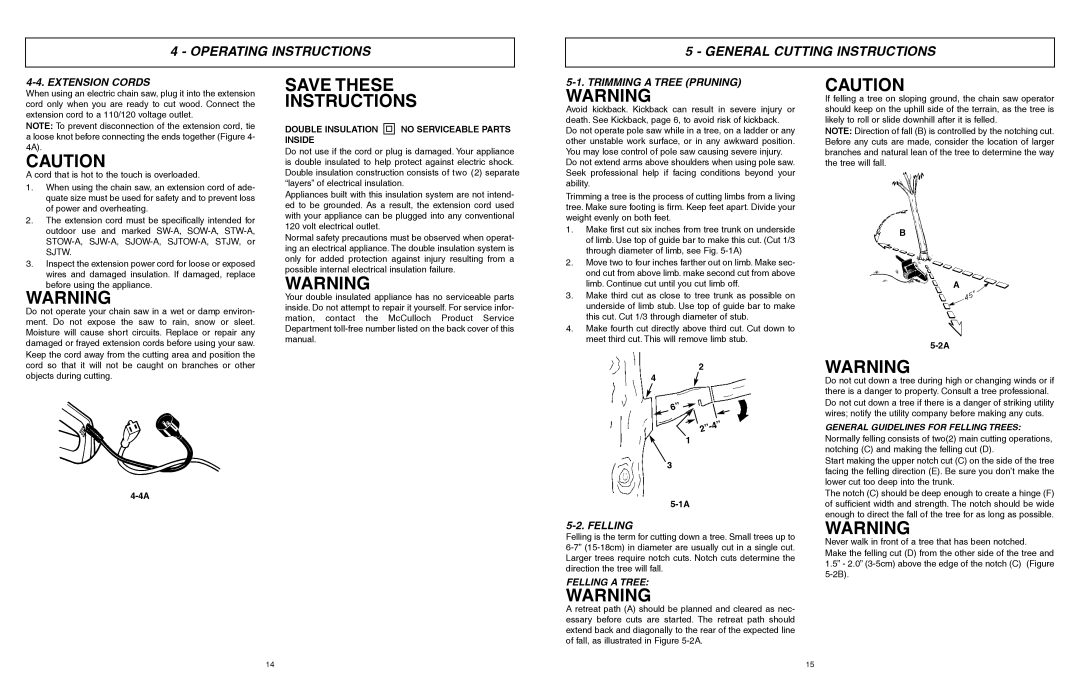
4 - OPERATING INSTRUCTIONS
5 - GENERAL CUTTING INSTRUCTIONS
When using an electric chain saw, plug it into the extension | SAVE THESE |
|
|
cord only when you are ready to cut wood. Connect the | INSTRUCTIONS |
extension cord to a 110/120 voltage outlet. |
|
5-1. TRIMMING A TREE (PRUNING)
WARNING
Avoid kickback. Kickback can result in severe injury or death. See Kickback, page 6, to avoid risk of kickback.
CAUTION
If felling a tree on sloping ground, the chain saw operator should keep on the uphill side of the terrain, as the tree is likely to roll or slide downhill after it is felled.
NOTE: To prevent disconnection of the extension cord, tie a loose knot before connecting the ends together (Figure 4- 4A).
CAUTION
A cord that is hot to the touch is overloaded.
1. When using the chain saw, an extension cord of ade- quate size must be used for safety and to prevent loss of power and overheating.
2. The extension cord must be specifically intended for outdoor use and marked
3. Inspect the extension power cord for loose or exposed wires and damaged insulation. If damaged, replace before using the appliance.
WARNING
Do not operate your chain saw in a wet or damp environ- ment. Do not expose the saw to rain, snow or sleet. Moisture will cause short circuits. Replace or repair any damaged or frayed extension cords before using your saw. Keep the cord away from the cutting area and position the cord so that it will not be caught on branches or other objects during cutting.
DOUBLE INSULATION 


 NO SERVICEABLE PARTS INSIDE
NO SERVICEABLE PARTS INSIDE
Do not use if the cord or plug is damaged. Your appliance is double insulated to help protect against electric shock. Double insulation construction consists of two (2) separate “layers” of electrical insulation.
Appliances built with this insulation system are not intend- ed to be grounded. As a result, the extension cord used with your appliance can be plugged into any conventional 120 volt electrical outlet.
Normal safety precautions must be observed when operat- ing an electrical appliance. The double insulation system is only for added protection against injury resulting from a possible internal electrical insulation failure.
WARNING
Your double insulated appliance has no serviceable parts inside. Do not attempt to repair it yourself. For service infor- mation, contact the McCulloch Product Service Department
Do not operate pole saw while in a tree, on a ladder or any other unstable work surface, or in any awkward position. You may lose control of pole saw causing severe injury.
Do not extend arms above shoulders when using pole saw. Seek professional help if facing conditions beyond your ability.
Trimming a tree is the process of cutting limbs from a living tree. Make sure footing is firm. Keep feet apart. Divide your weight evenly on both feet.
1.Make first cut six inches from tree trunk on underside of limb. Use top of guide bar to make this cut. (Cut 1/3 through diameter of limb, see Fig.
2.Move two to four inches farther out on limb. Make sec- ond cut from above limb. make second cut from above limb. Continue cut until you cut limb off.
3.Make third cut as close to tree trunk as possible on underside of limb stub. Use top of guide bar to make this cut. Cut 1/3 through diameter of stub.
4.Make fourth cut directly above third cut. Cut down to meet third cut. This will remove limb stub.
2
4
6”
1
3
NOTE: Direction of fall (B) is controlled by the notching cut. Before any cuts are made, consider the location of larger branches and natural lean of the tree to determine the way the tree will fall.
B
A
WARNING
Do not cut down a tree during high or changing winds or if there is a danger to property. Consult a tree professional. Do not cut down a tree if there is a danger of striking utility wires; notify the utility company before making any cuts.
GENERAL GUIDELINES FOR FELLING TREES:
Normally felling consists of two(2) main cutting operations, notching (C) and making the felling cut (D).
Start making the upper notch cut (C) on the side of the tree facing the felling direction (E). Be sure you don’t make the lower cut too deep into the trunk.
5-2. FELLING
Felling is the term for cutting down a tree. Small trees up to
FELLING A TREE:
WARNING
A retreat path (A) should be planned and cleared as nec- essary before cuts are started. The retreat path should extend back and diagonally to the rear of the expected line of fall, as illustrated in Figure
The notch (C) should be deep enough to create a hinge (F) of sufficient width and strength. The notch should be wide enough to direct the fall of the tree for as long as possible.
WARNING
Never walk in front of a tree that has been notched.
Make the felling cut (D) from the other side of the tree and 1.5” - 2.0”
14
15
